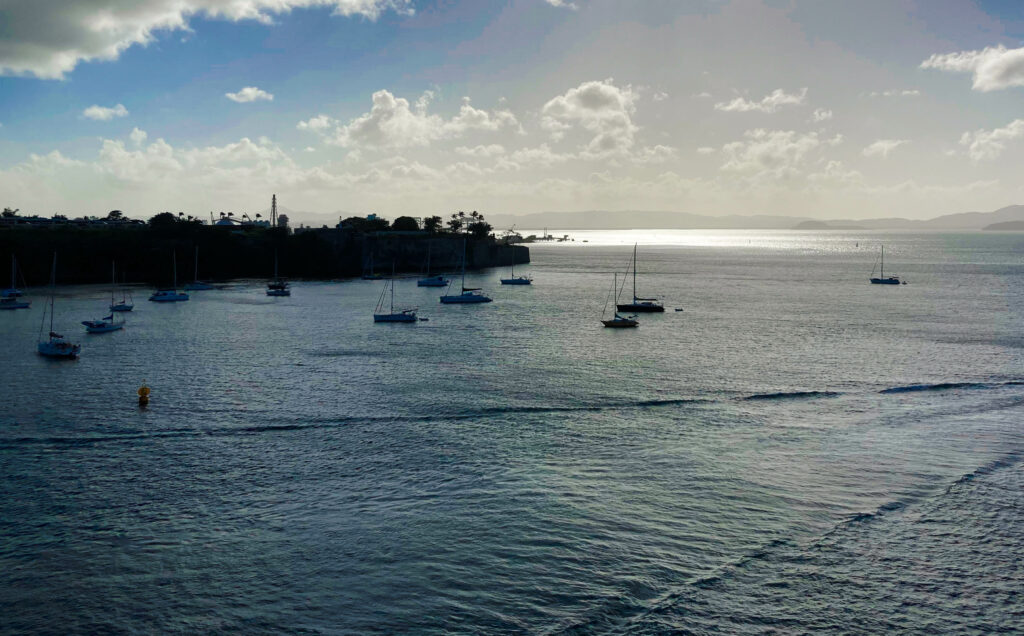The deadliest volcano eruptions in Caribbean history began in the spring of 1902.
This post contains affiliate links. For more information, click here.
On April 23, Mount Pelée exploded in northwest Martinique, approximately 1,500 miles from Miami.
Eruptions would continue for several days, then subside, resume, and then lull again.
On the morning of May 8, the biggest explosion boomed, and glowing lava sped down the side of the volcano, reaching the town of Saint-Pierre within minutes.
Hot ash ignited a firestorm, fueled by casks of rum. Ships at anchor caught fire in the harbor.
Major explosions occurred again on May 20 and August 30, followed by smaller blasts that continued for more than three years.
The volcano killed approximately 30,000 people, nearly three times as many as Italy‘s Mount Vesuvius in 79 A.D.
It destroyed Saint-Pierre, the cultural center of Martinique, once known as the “Paris of the Caribbean”.
The tragic event shaped modern vulcanology, the study of volcanoes. I was looking forward to Holland America‘s shore excursion to Saint-Pierre, which included a visit to a local museum and memorial that houses hundreds of objects recovered from the area, including a church bell twisted by the extreme heat.
Unfortunately, the tour was cancelled. So I signed up instead for “A Stroll through Historic Fort-de-France”, the French territory’s capital. I wasn’t sure what to expect. Historic cities are like billionaires and alpha males; the real ones don’t feel compelled to advertise it.
But Fort-de-France is certainly historic, though a recurring theme of the tour was recent efforts to send its history down the memory hole.
Christopher Columbus charted Martinique in 1493. In 1635, a trader named Pierre Belain d’Esnambuc established a French colony on the island.
In 1935, Martinique celebrated its 300th anniversary and put up a statue of its French founder in Fort-de-France. In 2020, rioters tore the statue down.
In 1763, Marie Josèphe Rose Tascher de La Pagerie was born on Martinique. In 1779, she married Alexandre, Viscount Beaumarchais. The couple had two children.
Beaumarchais died on the guillotine in Paris during the French Revolution’s Reign of Terror in 1794.
Two years later, the widow married Napoleon Bonaparte, who called her Josephine.
In 1802, as First Consul of France, he reinstated slavery in Caribbean colonies, where it had been abolished during the Revolution.
In 1804, he crowned himself and Josephine as emperor and empress at the Cathédrale Notre-Dame de Paris.
In 1810, he had the marriage annulled, because the couple had not produced children. She died in 1814; he died in 1821.
In 1859, her grandson (by Beaumarchais) Napoleon III commissioned an elegant statue of Josephine that stood in a park in Fort-de-France.
In 1991, it was decapitated and splashed with red paint, in protest of the 1802 reinstatement of slavery. Over the years, more and more red paint would deface it. Then in 2020, rioters tore what remained of the statue down. The head is still missing.
In 1848, Victor Schoelcher, a member of the French National Assembly, drafted the decree through which France finally abolished slavery in all its colonies and granted citizenship to the freed slaves.
In 1998, a statue of Schoelcher was erected in Fort-de-France to mark the 150th anniversary of abolition. In 2020, rioters decapitated the statue and tore it down.
Fortunately, they haven’t yet destroyed the Bibliothèque Schoelcher.
Believing that abolition was impractical without education, Schoelcher gave about 10,000 books from his own collection to Martinique.
The library was built in France in 1889, then shipped piece by piece to Fort-de-France and rebuilt to house them.
Unfortunately, a fire destroyed most of Schoelcher’s books in 1890. But the unique building still stands, with its ornate design, Byzantine glass dome, and names of French writers etched in its façade.
Even more magnificent, and also still standing, is the Cathédrale Saint-Louis.
Completed in 1895, the gothic-revival church features a cast-iron framework and a steeple that reaches 187 feet high. Architectural detail includes rounded arches and flying buttresses.
The interior boasts a grand pipe organ, Biblical art, and stunning stained glass windows.
After the tour, I walked back to the pier, re-embarked Nieuw Statendam, and read for a while.
Just before sunset, my cruise companions and I stood on deck and caught glimpses of the villages that mark the remains of Saint-Pierre as the ship sailed past Mount Pelée and out to sea.
Continue your adventure in the Caribbean:
After my misspent youth as a wage worker, I’m having so much more fun as a blogger, helping other discerning travellers plan fun and fascinating journeys. Read more …

